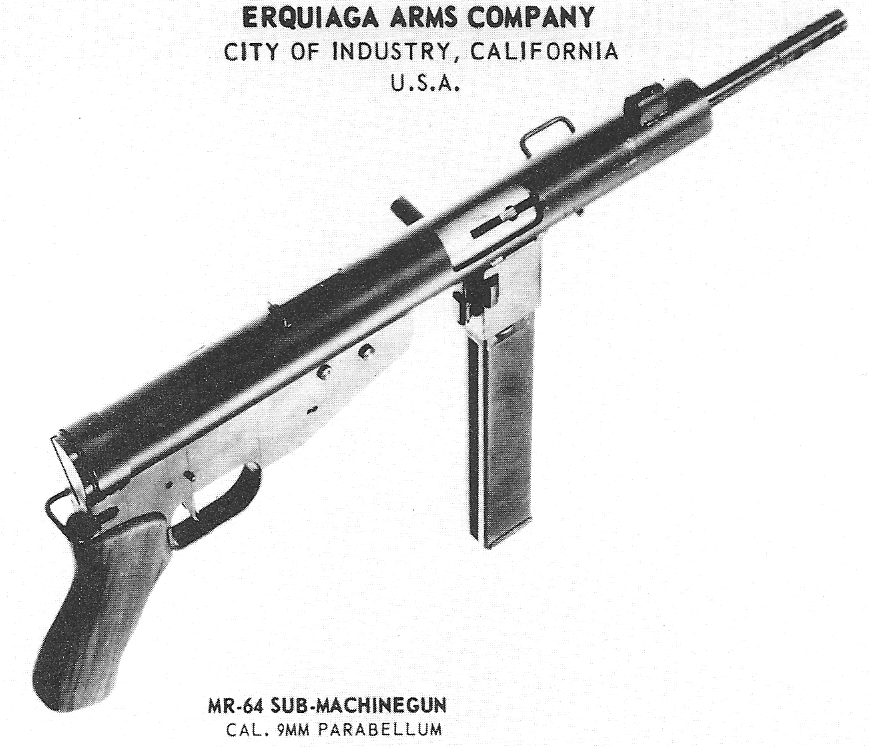

The MR-64 is a rather unremarkable submachine gun with an interesting history attached to it. The designer of this gun was one Juan Erquiaga Azicorbe, a former Peruvian military officer and engineer who was involved in some less than legal activities, namely gun running in Latin America. In the early 1950s Erquiaga appears in the United States working for the Police Ordnance Company. It is probably no mere coincidence that just a few years earlier, Gordon Ingram, one of the founders of the aforementioned firm, had taken a lengthy business trip to Peru to established production facilities for his Model 6 submachine gun. Some authors seem to have tried to downplay Ingram's involvement with Erquiaga, but it is fairly obvious that the two were close associates during this period.
By the mid-1950s, Erquiaga, still in the US, was producing homemade SMGs at an underground workshop in California. His intent was to sell them to revolutionary forces in Cuba and he was in direct contact with some of Castro's allies. Erquiaga's friends at the Police Ordnance Company were involved in this scheme, despite the fact that the company was an official supplier of SMGs to the Batista government. The plans were thwarted by the FBI, who caught wind of Erquiaga's activities. Erquiaga was tipped off early and fled to Mexico, where he continued to manufacture workshop-made guns for Cuban rebels, until in 1959 Castro's forces emerged victorious and their domestic struggle was over.
Eventually the heat died down in the US and Erquiaga slipped back to California, where in 1962 he rented a factory in El Monte and established the Erquiaga Arms Company. Immediately he was back under FBI surveillance, who were well aware that the company was a front for more illegal arms deals. The firm maintained a cloak of legitimacy by manufacturing and selling legal firearms for the civilian market, but behind the scenes Erquiaga was working on a new guerrilla gun, which he named the MR-64. These guns were intended for Cuban rebels of a very different sort: pro-Batista exiles who were intent on inciting a counter-revolution. This group was located in Miami and planned to ship the guns via boat to their allies within Cuba itself. Erquiaga intended to disguise these deliveries as military exports to Costa Rica, whose government agreed to "place" the orders.

In early 1964 Erquiaga sent a pilot batch of prototypes to Miami, but the delivery was intercepted by the FBI. Somehow, however, the FBI only managed to recover one gun and the rest were quickly diverted to the Dominican Republic, where they were instead sold to Communist revolutionaries in Santo Domingo. The Cubans in Miami never received any of these guns, and this episode proves, along with his earlier activities on behalf of Castro, that Erquiaga's political allegiances were practically nonexistent and the man was concerned solely with profiteering from these arms sales. Nevertheless, the Cubans retained their trust in Erquiaga and patiently waited for the next batch to be sent. The FBI, meanwhile, felt they had all the evidence they need to put Erquiaga out of operation. But Erquiaga seemed to have sympathizers in Washington DC, who were happy to turn a blind eye to his activities under the pretense that Erquiaga had a legitimate tax stamp to produce and export arms to Costa Rica. It was clearly obvious that none of the guns were actually going to Costa Rica, but there were no doubt government officials who were willing to allow it to happen in the hopes that the plot might destabilize Castro's government.
Erquiaga moved his factory to the City of Industry and continued the operation as planned. He hired Gordon Ingram to work on the project as the chief engineer and some minor modifications to the design were made. Over the next few months some 476 units were produced and a suppressor attachment for the gun was developed. Work was coming along promisingly and by early 1965 the shipment was ready to be delivered to Miami. But the Costa Rican government got cold feet and backed out of the deal, comprimising Erquiaga's plausible deniability. With no Costa Rican front, the orders were exposed and the FBI saw the opportunity to raid the factory. All 476 guns were confiscated and some of Erquiaga's associates were arrested, but the man himself had once again fled the country and returned to Peru (with his tail between his legs, one should imagine). It seems that Erquiaga never returned to the US after this and instead wandered South America for the rest of his days, working on-and-off for various engineering firms.
As mentioned in the beginning of this article, the MR-64 was not a particularly interesting gun design-wise. It was a basic copy of the Sten chambered in 9x19mm Parabellum, firing in full-auto only. Early models were incredibly simplistic and were made from as few parts as possible. When Ingram became attached to the project, some changes were made to the design that included a detachable dead weight that could be fitted onto the bolt to moderate the fire rate. Both models had a three-hole muzzle brake designed to control flash and recoil. Neither had buttstocks. The overall construction was apparently quite good, despite the crude appearance; although the machining processes were basic, the quality of metals used were decent enough.

